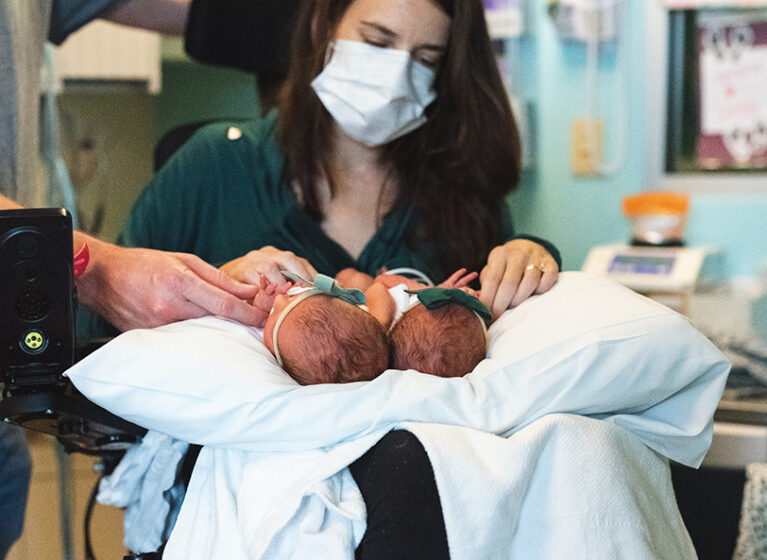
As medical professionals across the globe struggled against the impact of the emerging COVID-19 pandemic, a multidisciplinary team at UVA Health had cause for celebration: They delivered healthy twins to a quadriplegic, first-time mother in April 2020.
Pregnancy with twins can be complicated under the best circumstances. But women with disabilities face higher risks of complications and death than others, according to a study by the National Institutes of Health (NIH). There are only a handful of documented, successful quadriplegic twin births in the world. UVA Health offers the breadth of services and specialties the patient needed throughout her pregnancy.
A Healthy, Paralyzed Pregnant Woman Is Doubly Surprised
The patient, who became a quadriplegic after suffering a spinal cord injury at age 23, came to the UVA Health Maternal and Fetal Medicine Clinic in the early weeks of her pregnancy. Then in her mid-30s, the patient and her husband were elated to become parents. But they were surprised — and a little apprehensive — when Robert R. Fuller, MD, PhD, a maternal-fetal medicine specialist at UVA Health, announced that she was having twins.
Would her body endure the effects of pregnancy, especially with twins?
In her blog, the patient recalls Fuller’s reassuring observation: “You have a disability and have dealt with its challenges,” he told her. “You’re already equipped to handle this pregnancy.”
Prenatal Care for Quadriplegic Mother’s Special Circumstances
A typical pregnancy involves 12 to 14 prenatal visits, and a pregnancy with twins may involve a few additional visits. Despite her spinal cord injury, Fuller says this patient was healthier than many of the nondisabled patients he cares for in the high-risk clinic.
“A person's health matters in how well they do in pregnancy, and this patient was a healthy woman,” Fuller says. “She just happens to have a spinal cord injury. She didn't have many of the medical considerations that we often see in our high-risk clinic.”
One unique concern was the patient’s infraumbilical urinary diversion. It was critical to make sure it stayed intact as two babies grew inside the uterus. The maternal-fetal medicine team coordinated the patient’s care with UVA Health urology specialists, who monitored the function of the urinary diversion during her pregnancy.
“We didn’t want her pregnancy to disrupt or injure the urinary diversion,” Fuller says. “And if she ended up needing a C-section, we wouldn’t want to create a new surgical problem from something that's already working.”
Monitoring a Potentially Life-Threatening Condition
For any patient with a spinal cord injury or a neurodegenerative disorder, such as multiple sclerosis, autonomic dysreflexia (AD) can be a life-threatening concern that must be monitored closely during pregnancy. AD is an abnormal overreaction of the involuntary nervous system that can be triggered by normal functions such as excessive sweating, hiccups, intercourse, constipation, full bladder, and more. It causes a rapid and severe increase in blood pressure that may lead to stroke, seizures, or cardiac arrest.
Fuller and his team carefully managed this patient’s blood pressure during pregnancy, and she didn’t require any hospitalizations during pregnancy until the time of delivery. During labor and delivery, Fuller says AD can be managed with epidural or spinal anesthesia to reduce the physiologic response to pain that may lead to AD complications. Additionally, there are medical and nonmedical techniques for managing blood pressure concerns in AD patients.
“AD can happen at any point in the pregnancy,” Fuller says. “Fetal movements or contractions can even trigger AD symptoms. This patient was aware of the things that triggered her AD symptoms and knew how to manage them. AD did play a role in her pregnancy, labor, and delivery. But it was identified early and appropriately managed. Fortunately, there were no injuries or adverse events from it.”
The Birth Plan: Flexibility Is Key
Quadriplegics can deliver babies vaginally, and this was the plan for Fuller’s patient. However, after her labor began six weeks early, doctors realized that one baby was in a breech presentation. That meant she would need a cesarean section.
“A breech presentation is more common in women with paralysis for reasons that we don't completely understand,” Fuller says. “Women with paralysis are more likely to need a C-section because of the presentation of the baby.”
The COVID-19 Factor
The coronavirus pandemic added another complicating layer to the final weeks of this patient’s pregnancy. Businesses and schools across the country were shutting down. Many hospitals were restricting visitation. Fortunately, UVA Health never adopted a “no visitor” policy. This patient was able to have her husband by her side during labor and delivery.
“We did not have a full understanding of what COVID would do, so it was a really big deal,” Fuller says. “We dealt with a lot of unknowns and uncertainties about how people needed to be cared for.”
Equipped for the Most High-Risk Patients
Now 2 years old, the twin girls are thriving. Their mother’s story of pregnancy and parenting with a disability has been told in an award-winning documentary film.
UVA Health’s experienced maternal-fetal medicine specialists offer comprehensive services that any woman with a high-risk pregnancy could need. That includes access to experts in other medical and surgical disciplines, including urology, anesthesiology, cardiology, pulmonology, and critical care medicine. Additionally, UVA Health is home to the region’s most advanced neonatal intensive care unit (NICU), where this patient’s twins spent several days after their birth. UVA Children’s NICU is nationally ranked by U.S. News & World Report.
“UVA Health had a special role to play for this patient,” Fuller says. “She needed the breadth of services that UVA Health offers, and our level of expertise was appropriate for her care. It gave her a good home to welcome her twins. We took care of her with the same level of care and compassion that we give to all our high-risk patients.”